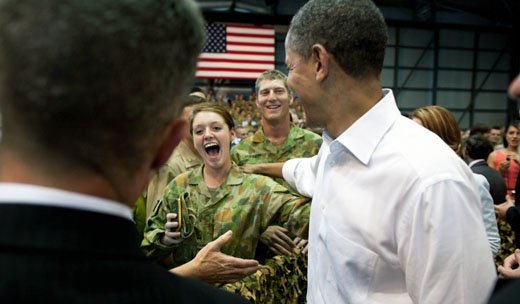
“On his recent trip to Asia Pacific, the President made it clear that the centerpiece of this strategy includes an intensified American role in this vital region,” Financial Times Nov. 28, 2011
– Tom Donilon, President Barak Obama’s national security advisor
“An Indo-Pacific without a strong U.S. military presence would mean the Finlandisation by China of countries in the South China Sea, such as Vietnam, Malaysia and Singapore,” Financial Times Nov. 30, 2011
– Robert Kaplan, senior fellow Center for a New American Security and author of “Monsoon:
The Indian Ocean the Future of American Power”
Donilon is a long-time Democratic Party operative and former lobbyist for Fannie Mae and a key figure in the Clinton administration’s attack on Yugoslavia and the expansion of NATO into Eastern Europe. Kaplan is a Harvard Business School professor and advisor on the Mujahedeen war against the Soviets in Afghanistan, as well as current U.S. military intervention in the Horn of Africa.
Something is afoot.
Indeed, it is. In both cases, a substantial buildup of military forces and a gloves-off use of force lie at the heart of the new approach.
The U.S. now has a permanent military force deployed in the Horn of Africa, a continent-wide military command – Africom – and it has played a key role in overthrowing the Libyan government. It also has Special Forces active in Uganda, Somalia, and most of the countries that border the Sahara.
But it is in Asia that the administration is making its major push, nor is it coy about whom the target is. “We are asserting our presence in the Pacific. We are a Pacific power,” U.S. Secretary of State Hillary Clinton said at the National Defense University in August, “we know we face some long-term challenges about how we are going to cope with what the rise of China means.”
There is whiff to all this of old fashioned Cold War hype, when the U.S. pumped up the Russian military as a world-swallowing force panting to pour through the Fulda Gap and overrun Western Europe: the Chinese are building a navy to challenge the U.S.; the Chinese are designing special missiles to neutralize American aircraft carriers; the Chinese are bullying nations throughout the region.
Common to Clinton’s address, as well as to Kaplan’s and Donilon’s opinion pieces, were pleas not to cut military spending in the Pacific. In fact, it appears the White House is already committed to that program. “Reduction in defense spending will not come at the expense of the Asia Pacific,” Donilon wrote, “There will be no diminution of our military presence or capabilities in the region.”
The spin the White House is putting on all this is that the U.S. has been bogged down in Iraq and Afghanistan, allowing China to throw its weight around in Asia. Donilon’s opinion piece was titled “America is back in the Pacific and will uphold the rules.”
It is hard to know where to begin to address a statement like that other than with the observation that irony is dead.
Asia and the Pacific has been a major focus for the U.S. since it seized the Philippines in the 1899 Spanish-American War. It has fought four major wars in the region over the past century, and, not counting China’s People’s Liberation Army (PLA), it deploys more military personnel in the Pacific than any other nation. It dominates the region through a network of bases in Japan, the Philippines, South Korea, Malaysia, Thailand, Singapore, the Marshall Islands, and island fortresses like Guam and Wake. The White House just announced the deployment of 2,500 Marines to Australia.
The American Seventh Fleet – created in 1943 and currently based in Yokosuka, Japan – is the largest of the U.S.’s naval fleets, and the one most heavily armed with nuclear weapons.
We aren’t “back,” we never went anywhere.
But the argument fits into the fable that U.S. military force keeps the peace in Asia. Kaplan even argues, “A world without US naval and air dominance will be one where powers such as China, Russia, India, Japan and others act more aggressively toward each other than they do now, because they will all be far more insecure than they are now.”
In short, the kiddies will get into fights unless Uncle Sam is around to teach them manners. And right now, China is threatening to upend “the rules” through an aggressive expansion of its navy.
China is indeed upgrading its navy, in large part because of what the Seventh Fleet did during the 1995-96 Taiwan Straits crisis. In the middle of tensions between Taipei and Beijing, the Clinton administration deployed two aircraft carrier battle groups into the Taiwan Straits. Since there was never any danger that China was going to invade Taiwan, the carriers were just a gratuitous slap in the face. China had little choice but to back down, but vowed it would never again be humiliated in its home waters. Beijing’s naval buildup dates from that crisis.
And “buildup” is a relative term. The U.S. has made much of China acquiring an aircraft carrier, but the “new” ship is a 1990 vintage Russian carrier, less than half the size of the standard American Nimitz flattop (of which the U.S. has 10). The “new” carrier-killer Chinese missile has yet to be tested, let alone deployed. Only in submarines can China say it is finally closing the gap with the U.S. And keep in mind that China’s military budget is about one-eighth that of the U.S.
If the Chinese are paranoid about their sea routes and home waters, it is not without cause. Most invasions of China have come via the Yellow Sea, and 80 percent of China’s energy supplies come by sea. China ships much of its gas and oil through the Indian Ocean and the South China Sea. With major suppliers based on the west coast of Africa, the Red Sea and the Persian Gulf, it has little choice. Those sea-lanes are controlled by the U.S. Fifth Fleet based in Bahrain and the Seventh in Japan.
China is also building friendly ports for its tankers – the so-called “string of pearls” – and that is why Beijing is suspicious about the sudden thaw in U.S.-Myanmar relations. China plans to build a “pearl” in Myanmar.
Indeed, a major reason why China is building pipelines from Russia and Central Asia is to bypass the series of choke points through which its energy supplies pass, including the straits of Hormuz and the Malacca Strait. The Turkmenistan-Xingjian and Eastern Siberia Pacific Ocean pipelines are already up and running, but their volume is not nearly enough to feed China’s 11 billion barrels of oil a day appetite.
In spite of protests, the U.S. recently carried out major naval operations in the Yellow Sea, and Washington has injected itself into tensions between Beijing and some of its neighbors over the South China Sea. In part, China has exacerbated those tensions by its own high-handed attitude toward other nations with claims on the Sea. In responding to protests over China’s claims, Chinese Foreign Minister Yang Jiechi remarked, “China is a big country and other countries are small countries, and that is just a fact.”
China’s initial arrogance on the issue has allowed the U.S. to wedge itself into the dispute and portray itself as the “protector” of small nations. Less than 40 years ago it was trying to bomb several of those nations back into the Stone Age, and Vietnam just recorded its 100,000th casualty since 1975 from explosives left over by the American war.
Beijing has since cooled its tone on the South China Sea and is backing away from defining it as a “core” Chinese area.
Why the “strategic pivot?” Undoubtedly, some of it is posturing for the run-up to the 2012 elections. Being “tough” on China trumps Republican charges that Obama is “soft” on foreign policy. But this “pivot” is more than cynical electioneering.
First, China does not pose any military threat to the U.S. or its allies in Asia, and the last thing it wants is a war. Beijing has not forgotten its 1979 invasion of Vietnam that ended up derailing its “four modernizations” drive and deeply damaging its economy.
Part of this “China threat” nonsense has to do with the power of the U.S. armaments industry to keep the money spigots open. When it comes to “big ticket” spending items, navies and air forces top the list. An aircraft costs in excess of $5 billion, and the single most expensive weapons program in U.S. history is the F-35 stealth fighter.
But there is more than an appetite for pork at work here.
China is the number two economy in the world, and in sharp competition with the U.S. and its allies for raw materials and human resources. It is hard to see the aggressive U.S. posture in Asia as anything other than an application of the old Cold War formula of economic pressure, military force, and diplomatic coercion. From Washington’s point of view, it worked to destabilize the Soviet Union, why shouldn’t it work on China?
“If you are a strategic thinker in China,” says Simon Tay, chair of the Singapore Institute of International Affairs, “you do not have to be a paranoid conspiracy theorist to think that the U.S. is trying to bandwagon Asia against China.”
Since U.S. foreign policy is almost always an extension of corporate interests, squeezing China in Asia, Africa and Central Asia helps create openings for American investments. And if such a policy also protects the multi-billion dollar military budget, including the likes of Lockheed Martin, Boeing, General Dynamics and Northrop Grumman, so much the better.
It is a dangerous game, first, because military tension can lead to war, and, while that is an unlikely event, mistakes happen. “If we keep this up, then we are going to leave the impression with China that we are drawing battle lines,” Douglas Paal of the Carnegie Endowment for International Peace told the Financial Times. In fact, the Obama administration has drawn up a plan called AirSea Battle to deny China control of the Taiwan Straits.
The consequences for those caught in the middle will be severe. China has pulled hundreds of millions of people out of poverty, but it still has a ways to go. An arms race will delay that. For the average American, racked by double-digit unemployment, a vanishing safety net, and the collapse of everything from education to infrastructure, it will be no less of a tragedy.
This article originally appeared in Dispatches from the Edge and Counterpunch.
Photo: Creative Commons 2.0










